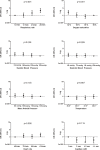Vital signs and impaired cognition in older emergency department patients: The APOP study
- PMID: 31220173
- PMCID: PMC6586336
- DOI: 10.1371/journal.pone.0218596
Vital signs and impaired cognition in older emergency department patients: The APOP study
Abstract
Background/objectives: Cognitive impairment is a frequent problem among older patients attending the Emergency Department (ED) and can be the result of pre-existing cognitive impairment, delirium, or neurologic disorders. Another cause can also be acute disturbance of brain perfusion and oxygenation, which may be reversed by optimal resuscitation. This study aimed to assess the relationship between vital signs, as a measure of acute hemodynamic changes, and cognitive impairment in older ED patients.
Design: Prospective cohort study.
Setting: ED's of two tertiary care and two secondary care hospitals in the Netherlands.
Participants: 2629 patients aged 70-years and older.
Measurements: Vital signs were measured at the moment of ED arrival as part of routine clinical care. Cognition was measured using the Six-Item Cognitive Impairment Test (6-CIT).
Results: The median age of patients was 78 years (IQR 74-84). Cognitive impairment was present in 738 patients (28.1%). When comparing lowest with highest quartiles, a systolic blood pressure of <129 mmHg (OR 1.30, 95% confidence interval (95%CI) 0.98-1.73)was associated with increased risk of cognitive impairment. A higher respiratory rate (>21/min) was associated with increased risk of impaired cognition (OR 2.16, 95% CI 1.58-2.95) as well as oxygen saturation of <95% (OR 1.64, 95%CI 1.24-2.19).
Conclusion: Abnormal vital signs associated with decreased brain perfusion and oxygenation are also associated with cognitive impairment in older ED patients. This may partially be explained by the association between disease severity and delirium, but also by acute disturbance of brain perfusion and oxygenation. Future studies should establish whether normalization of vital signs will also acutely improve cognition.
Conflict of interest statement
The authors have declared that no competing interests exist.
Figures



Similar articles
-
Impaired cognition is associated with adverse outcome in older patients in the Emergency Department; the Acutely Presenting Older Patients (APOP) study.Age Ageing. 2018 Sep 1;47(5):679-684. doi: 10.1093/ageing/afx174. Age Ageing. 2018. PMID: 29177470
-
Vital Signs Predict Rapid-Response Team Activation Within Twelve Hours of Emergency Department Admission.West J Emerg Med. 2016 May;17(3):324-30. doi: 10.5811/westjem.2016.2.28501. Epub 2016 Apr 26. West J Emerg Med. 2016. PMID: 27330665 Free PMC article.
-
Vitamin D Deficiency and Long-Term Cognitive Impairment Among Older Adult Emergency Department Patients.West J Emerg Med. 2019 Oct 16;20(6):926-930. doi: 10.5811/westjem.2019.8.43312. West J Emerg Med. 2019. PMID: 31738720 Free PMC article.
-
Screening instruments for cognitive impairment in older patients in the Emergency Department: a systematic review and meta-analysis.Age Ageing. 2021 Jan 8;50(1):105-112. doi: 10.1093/ageing/afaa183. Age Ageing. 2021. PMID: 33009909 Free PMC article.
-
Validity and Reliability of the 6-Item Cognitive Impairment Test for Screening Cognitive Impairment: A Review.Dement Geriatr Cogn Disord. 2016;42(1-2):42-9. doi: 10.1159/000448241. Epub 2016 Aug 19. Dement Geriatr Cogn Disord. 2016. PMID: 27537241 Review.
Cited by
-
Non-conveyance of older adult patients and association with subsequent clinical and adverse events after initial assessment by ambulance clinicians: a cohort analysis.BMC Emerg Med. 2021 Dec 11;21(1):154. doi: 10.1186/s12873-021-00548-7. BMC Emerg Med. 2021. PMID: 34895152 Free PMC article.
-
Intercepting Dementia: Awareness and Innovation as Key Tools.Front Aging Neurosci. 2021 Oct 13;13:730727. doi: 10.3389/fnagi.2021.730727. eCollection 2021. Front Aging Neurosci. 2021. PMID: 34720991 Free PMC article.
-
Neurovascular phase coherence is altered in Alzheimer's disease.Brain Commun. 2025 Feb 3;7(1):fcaf007. doi: 10.1093/braincomms/fcaf007. eCollection 2025. Brain Commun. 2025. PMID: 40008330 Free PMC article.
-
Prevalence and clinical significance of point of care elevated lactate at emergency admission in older patients: a prospective study.Intern Emerg Med. 2022 Sep;17(6):1803-1812. doi: 10.1007/s11739-022-03005-w. Epub 2022 Jun 9. Intern Emerg Med. 2022. PMID: 35678940 Free PMC article.
-
Geriatric Screening, Triage Urgency, and 30-Day Mortality in Older Emergency Department Patients.J Am Geriatr Soc. 2020 Aug;68(8):1755-1762. doi: 10.1111/jgs.16427. Epub 2020 Apr 4. J Am Geriatr Soc. 2020. PMID: 32246476 Free PMC article.
References
-
- Schofield I, Stott DJ, Tolson D, McFadyen A, Monaghan J, Nelson D. Screening for cognitive impairment in older people attending accident and emergency using the 4-item Abbreviated Mental Test. European journal of emergency medicine: official journal of the European Society for Emergency Medicine. 2010;17(6):340–2. 10.1097/MEJ.0b013e32833777ab . - DOI - PubMed
-
- Lucke JA, de Gelder J, Heringhaus C, van der Mast RC, Fogteloo AJ, Anten S, et al. Impaired cognition is associated with adverse outcome in older patients in the Emergency Department; the Acutely Presenting Older Patients (APOP) study. Age and ageing. 2017:1–6. Epub 2017/11/28. 10.1093/ageing/afx174 . - DOI - PubMed
Publication types
MeSH terms
LinkOut - more resources
Full Text Sources
Medical

